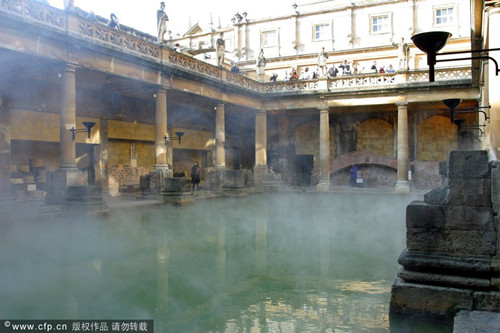|
World Cultural Heritage-- Roman Baths

The Roman Baths complex is a site of historical interest in the English city of Bath. The house is a well-preserved Roman site for public bathing.
The Roman Baths themselves are below the modern street level. There are four main features: the Sacred Spring, the Roman Temple, the Roman Bath House and the Museum holding finds from Roman Bath. The buildings above street level date from the 19th century.
The Baths are a major tourist attraction and, together with the Grand Pump Room, receive more than one million visitors a year, with 1,037,518 people during 2009. It was featured on the 2005 TV program Seven Natural Wonders as one of the wonders of the West Country. Visitors can see the Baths and Museum but cannot enter the water. An audio guide is available in several languages.
The water which bubbles up from the ground at Bath fell as rain on the nearby Mendip Hills. It percolates down through limestone aquifers to a depth of between 2,700 meters (8,900 ft) and 4,300 meters (14,100 ft) where geothermal energy raises the water temperature to between 64 °C (147.2 °F) and 96 °C (204.8 °F). Under pressure, the heated water rises to the surface along fissures and faults in the limestone. This process is similar to an artificial one known as Enhanced Geothermal Systemwhich also makes use of the high pressures and temperatures below the Earth's crust. Hot water at a temperature of 46 °C (114.8 °F) rises here at the rate of 1,170,000 liters (257,364 imp gal) every day,from a geological fault (the Penny quick fault). In 1983 a new spa water bore-hole was sunk, providing a clean and safe supply of spa water for drinking in the Pump Room.
Bath was charged with responsibility for the hot springs in a Royal Charter of 1591 granted by Elizabeth I. This duty has now passed to Bath and North East Somerset Council, who carry out monitoring of pressure, temperature and flow rates. The thermal waters contain sodium, calcium, chloride and sulphate ions in high concentrations.
The water that flows through the Roman Baths is considered unsafe for bathing, partly due to its having passed through the still-functioning original lead pipes, and up until World War II, it was advertised on the basis of the radioactivity it contained. However the more significant danger is now considered to be infectious diseases. In October 1978, a young girl swimming with the Bath Dolphins, a local swimming club, in the restored Roman Bath contracted meningitis and died,leading to the closure of the bath for several years.Tests showed that Naegleria fowleri, an amoeba, was in the water.The newly constructed Thermae Bath Spa nearby, designed by Nicholas Grimshaw and Partners, and the refurbished Cross Bath allow modern-day bathers to experience the waters via a series of more recently drilled boreholes.










